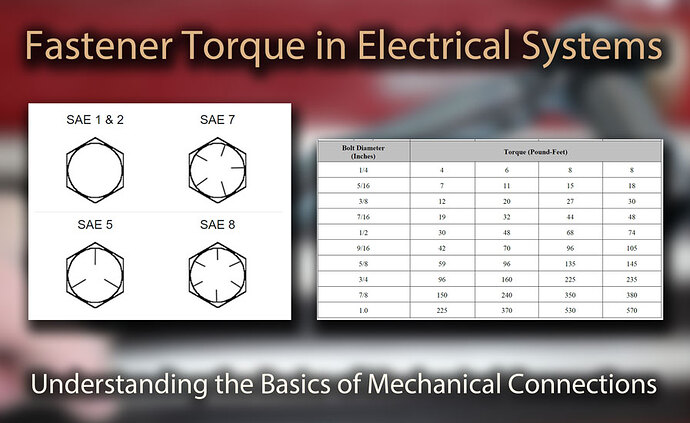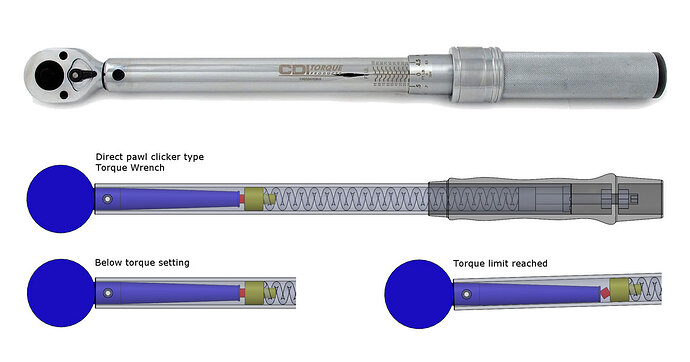Checking bolted electrical connections is a critical maintenance step for the safe and reliable operation of electric power systems. Proper mechanical torque ensures that the connections are secure, minimizing the risk of loose or overheating connections that can lead to electrical arcing, fire hazards, or system failure.
Adequate torque also maintains the integrity of the connection over time, preventing loosening due to vibrations or thermal expansion. It helps maintain optimal electrical performance, preventing voltage drops, power loss, and excessive energy consumption.
Following manufacturer’s recommended torque values for bolted electrical connections is essential to ensure safety, reliability, performance, and compliance with industry standards. Overtorquing can cause damage to the bolt, nut, or the electrical components being connected.
Excessive force can cause compression or deformation of the conductor, resulting in a reduction of its cross-sectional area, increased resistance, and potential overheating. This can lead to electrical faults, insulation breakdown, or even electrical fires.
SAE Grade Markings
The term “grade” refers to the markings or symbols found on fasteners, such as bolts, screws, or nuts, to indicate their strength or hardness according to the Society of Automotive Engineers (SAE) standards. These markings provide information about the material and mechanical properties of the fastener, allowing users to select the appropriate fastener for their application.
The SAE Grade Markings typically consist of numbers or alphanumeric codes, such as 2, 5, and 8, which represent different levels of strength, tensile strength, or hardness. The specific grade markings can vary depending on the type of fastener and the applicable SAE standard being used. These markings are crucial for ensuring the reliability and performance of fasteners.
The term “grade” refers to the markings or symbols found on fasteners. Photo: NETA MTS-2023
SAE grade markings on bolts can be identified by the presence of lines on the top of the bolt head. These lines, also known as radial lines or hash marks, are used to visually indicate the grade or strength of the bolt.
The number of lines corresponds to a specific grade, with each grade having a unique number of lines. For example, three lines may indicate a grade 5 bolt, while six lines may indicate a grade 8 bolt. By counting the lines on the top of the bolt head, users can quickly identify the SAE grade of the bolt and ensure they are using the appropriate strength level for their application.
Tensile Strength
The tensile strength of a bolt refers to its maximum resistance to being pulled apart or stretched under tension. It is a measure of the bolt’s ability to withstand a load or force applied in the direction that would elongate or stretch it.
Tensile strength is typically expressed in units of force per unit area, such as pounds per square inch (psi) or megapascals (MPa). A higher tensile strength indicates a stronger bolt that can handle greater loads or forces without breaking or deforming. It is an important factor to consider when selecting bolts for applications where high torque is expected.
Thread Pitch
US Standard Threads are measured in TPI, which stands for Threads per Inch. This measurement is determined by counting the number of thread crests found within one inch of the threaded portion. The threads are categorized into two main types: Coarse (NC) and Fine (NF).
Coarse threads have a lower TPI value, meaning there are fewer thread crests per inch, resulting in a larger pitch and faster assembly. On the other hand, Fine threads have a higher TPI value, indicating more thread crests per inch, resulting in a smaller pitch and finer adjustment capabilities.
The TPI measurement is essential for selecting the appropriate fasteners and ensuring compatibility between threaded components.
Tools and Test Equipment
The use of a torque wrench and a digital low-resistance ohmmeter can greatly aid in identifying and correcting improperly torqued electrical connections. The torque wrench allows for precise application of the recommended torque value, ensuring that connections are tightened to the appropriate level. This helps prevent under or overtorquing, reducing the risk of loose or damaged connections.
The torque wrench allows for precise fastener application. Photo: Wikimedia.
The digital low-resistance ohmmeter measures the resistance across the connection, providing an accurate indication of the quality of the electrical contact. If the resistance is higher than expected, it may indicate a poorly torqued connection, allowing for timely correction. By combining the use of these tools, technicians can ensure that electrical connections are properly torqued, minimizing the risk of electrical faults, failures, and safety hazards.
Related: Test Equipment 101: The Basics of Electrical Testing
How to determine the correct torque value for electrical connections
Manufacturers’ literature specifies the proper torque value for electrical power system connections based on design specifications by considering factors such as the size, material, and design of the connection. This information helps determine the appropriate torque level that ensures proper clamping force without damaging the components.
In cases where manufacturers’ literature is unavailable, industry standards such as NFPA and NETA can be relied upon. These standards provide guidelines and recommendations for torque values based on the grade and tensile strength of the fastener, ensuring that the connections are tightened to appropriate levels to maintain safety and reliability in the power system.
NETA Table 100.12 lists several acceptable torque values for US standard fasteners based on grade. The table provides a reference chart that indicates the recommended torque values for different grades of fasteners, such as Grade 2, Grade 5, and Grade 8. These torque values are specified in foot-pounds (ft-lbs) or inch-pounds (in-lbs) and can be used as a guide to ensure proper tightening of electrical connections, taking into account the strength and characteristics of the fastener being used.
Bolt-Torque Values for Electrical Connections
US Standard Fasteners (Heat-Treated Steel – Cadmium or Zinc Plated)
| Bolt Diameter | SAE 1&2 | SAE 5 | SAE 7 | SAE 8 |
|---|---|---|---|---|
| 1/4" | 4 | 6 | 8 | 8 |
| 3/8" | 12 | 20 | 27 | 30 |
| 1/2" | 30 | 48 | 68 | 74 |
| 9/16" | 42 | 70 | 96 | 105 |
| 3/4" | 96 | 160 | 225 | 235 |
Torque values are expressed in Pound-Feet, derived from NETA MTS-2023 Table 100.12. See original standard for more information.



